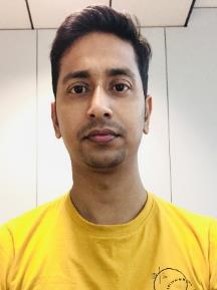
Research lines:
- Deciphering the role of charge transfer states in all organic photocatalysis.
Relevant publications
Indranil Bhattacharjee, Shuzo Hirata*“Highly Efficient Persistent Room‐Temperature Phosphorescence from Heavy Atom‐Free Molecules Triggered by Hidden Long Phosphorescent Antenna”. Advanced Materials, 2020, 32(31), 2001348. DOI: 10.1002/adma.202001348.
Takuya Kamatsuki, Indranil Bhattacharjee*, Shuzo Hirata* “The Substituent-Induced Symmetry-Forbidden Electronic Transition Allows Significant Optical Limiting under Weak Sky-Blue Irradiance”, The Journal of Physical Chemistry Letters, 2020, 11(20), 8675-8681. DOI: 10.1021/acs.jpclett.0c02694
Indranil Bhattacharjee, Nirmalya Acharya, Harsh Bhatia, Debdas Ray* “Dual Emission through Thermally Activated Delayed Fluorescence and Room-Temperature Phosphorescence, and Their Thermal Enhancement via Solid-State Structural Change in a Carbazole-Quinoline Conjugate”, The Journal of Physical Chemistry Letters, 2018, 9 (11), 2733-2738. DOI: 10.1021/acs.jpclett.8b00937
Indranil Bhattacharjee is working in the field of ‘Understanding the inherent photophysics of the Donor-Acceptor based pure organic molecules’. Started from his PhD. onwards he was keenly interested in the design, synthesis and characterization of those materials. In 2014 he joined Shiv Nadar University for his Ph.D. (with Dr. Debdas Ray) in the field of Physical and Material Chemistry. After completion of his Ph.D., he started his postdoctoral research with Dr. Shuzo Hirata at University of Electro-Communications, Japan as a UEC postdoctoral fellow.
Since 2022, he has been working at IMDEA Nanociencia as MSCA-IDEAL postdoctoral researcher IB is working in the field of understanding the photophysics of the pure organic Donor-Acceptor materials via spectroscopic and computational approach. This understanding will enrage the visibility in the field of application-based research like, optoelectronics, energy conversion and so on.
MEET DR BHATTACHARJEE
Concept of Dr Bhattacharjee’s project is to understand the photophysics of the pure organic photocatalyst and unveil the inherent mechanism for the betterment of the future research.
His current research plan is most dependent on the uses of various state-of-art instruments, and there are very few institutes where he can access all these under the same roof. In addition to that, IMDEA Nanociencia also has a significant impact at the league of the researcher, and that will amplify his research in the outer world.
Research in the field of OPCs has been highly enhanced in the last few years.
Dr Bhattacharjee will be involved in the quantum mechanical calculations and analysing the data using state-of-the-art ultrafast transient absorption technique as well as various other spectroscopic tools. Handling these kinds of instruments will enhance his capability and analysing the data will also intensify his knowledge not only on this specific field but also will help for better understand the various prospect of physical chemistry. He is quite sure that this fellowship will increase his potential as a researcher and also working in this project will broaden the path of his future research.
INTERVIEW
What does your research consist of in a broad sense?
I am working in the field of photophysical analysis of pure organic photocatalysis. In recent years pure organic photocatalyst are gain immense research interest. My main goal is to unveil the inherent mechanism of these materials via experiment and theoretical analysis.
What would you highlight from your experience in the laboratory?
In my research various spectroscopic tools are indeed very important. Research laboratory in IMDEA Nanociencia provides me the best equipped instruments in addition to that common laboratory instruments. Using these laboratory instruments, I can understand the inherent mechanisms of the desired materials.
How was your experience at IMDEA Nanociencia?
IMDEA Nanociencia provides a very comfortable research environment. Other than the specific research instruments and computational facilities, discussion research with eminent scientists provides also very common in here. This helps a better understanding of the results and future development.
How has your participation in IDEAL postdoctoral programme benefited your career?
IDEAL postdoctoral programme allows to do independent research with instrument and computational facilities. In addition to that, various career development sessions help to define several social causes which are indeed helpful to become as an independent researcher.
How do you see the future of nanoscience globally?
IMDEA nanoscience is a truly international institute, being a researcher in here, it is a fact that in next few years this institute will mark as a top-notch research institute in the world.
What direction will your career take after your time as an IDEAL fellow at IMDEA Nanociencia?
After completion of my tenure, I want to continue as an independent research scientist. Research activities, handling various instruments, computational analysis, etc. are very important aspect for becoming an independent researcher. In addition to that, other facts like, how to prepare research grants, gender equality, etc. are also very important for future career. IMDEA Nanociencia provides all these useful trainings for becoming a successful researcher.
More information on the IDEAL Fellowships Programme https://idealcofund-project.eu/postdoc/
The IDEAL Fellowships Programme is supported by the Marie Skłodowska-Curie Actions (MSCA) COFUND. Grant agreement ID: 101034431.
